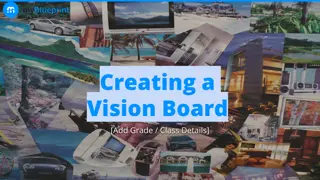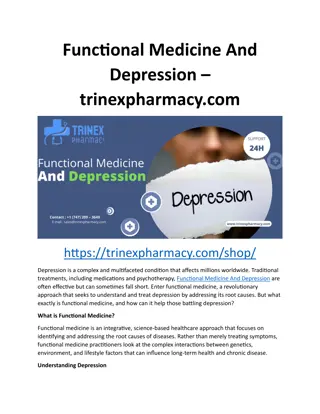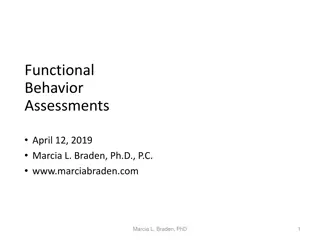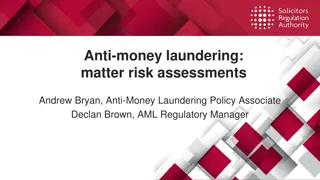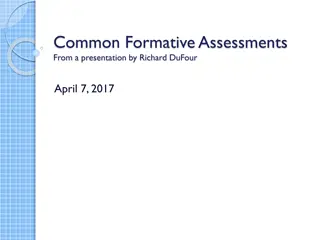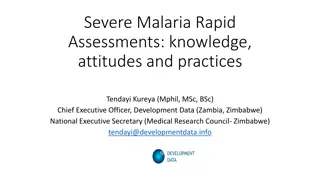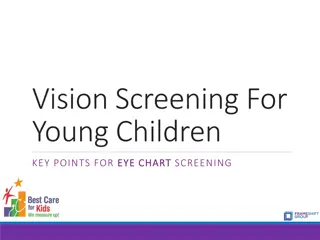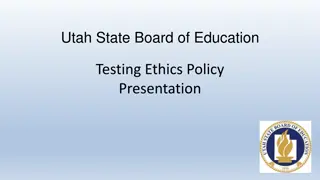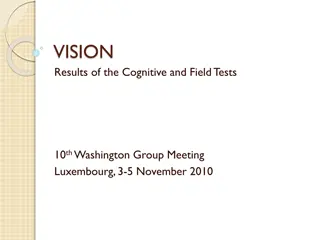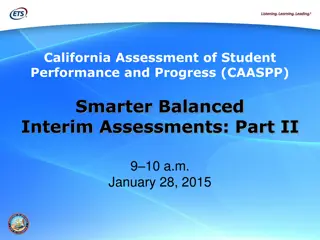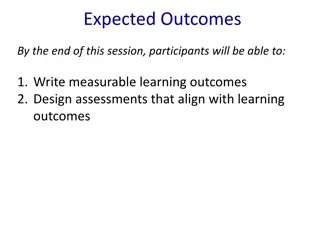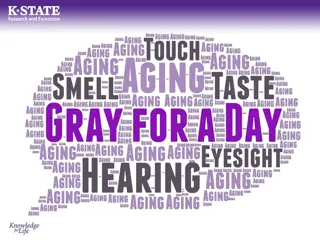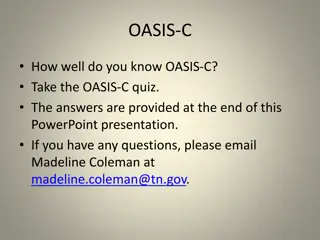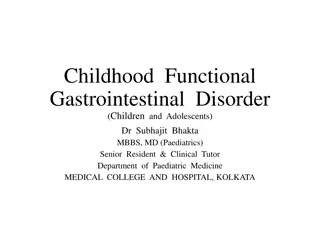Effective Practices for Functional Vision Assessments
This presentation covers the best practices, strategies, tools, and materials for conducting Functional Vision Assessments (FVA) effectively. It discusses the purpose of FVA, key ideas, the power of three tools, engagement ideas, and the role of IEP teams in using FVA results. The presentation emphasizes the importance of proper evaluation spaces, communication with students, conducting observations, and careful preparation for assessments. Utilize these tips to enhance the quality and outcomes of your FVA process.
Download Presentation

Please find below an Image/Link to download the presentation.
The content on the website is provided AS IS for your information and personal use only. It may not be sold, licensed, or shared on other websites without obtaining consent from the author.If you encounter any issues during the download, it is possible that the publisher has removed the file from their server.
You are allowed to download the files provided on this website for personal or commercial use, subject to the condition that they are used lawfully. All files are the property of their respective owners.
The content on the website is provided AS IS for your information and personal use only. It may not be sold, licensed, or shared on other websites without obtaining consent from the author.
E N D
Presentation Transcript
FVA Best Practices Jaime Pack-Adair, MA, cTVI
Purpose of FVA The Do s and the Don t s Best Practices Strategies Tools & Materials Q&A Today we will discuss 9/3/20XX FVA Best Practices 2
Key Ideas https://jamboard.google.com/d/1R xAM4rLDafxkZo88uM1ItxllTr6RQp M- A5WSW1Bugtg/edit?usp=sharing 9/3/20XX Presentation Title 3
The Power of Three Tools, Teaching strategies Engagement ideas Workbook Questions 9/3/20XX Presentation Title 4
IEP teams use the results to determine: Eligibility for Special Education Services Necessary accommodations & interventions Determine IEP Goals Identify focus of Specially Designed Instruction Required by IDEA (2004) Purpose of an FVA Holbrook et al., 2017; Individuals with Disabilities Education Improvement Act, 2004). Kaiser, J. T., & Herzberg, T. S. (2021). An Analysis of Data Collection Tools Used When Completing Functional Vision Assessments. Journal of Visual Impairment & Blindness, 115(1), 17 27. https://doi.org/10.1177/0145482X20987015 9/3/20XX Presentation Title 5
Identify a space/time to do the evaluation. Select developmentally appropriate assessment tools. Communicate to the student about what you are doing & why. Take detailed notes. Conduct in an hour or less. Communicate Be prepared Have your templates ready Have all materials ready Know the student s eye condition & additional disabilities before the assessment. The Do s . 9/3/20XX Presentation Title 6
Conduct observations throughout the student s day Take pictures of how the student is using their vision Engage students to be active participants in their assessment The Do s Continued Clark, 2022 9/3/20XX Presentation Title 7
Preparation Wear a solid color shirt Be aware of jewelry, IDs, lanyards, keys that may be distracting Have a clear assessment space Have all materials prepped and ready for use Be aware of lighting, noise, clutter, distractions 9/3/20XX Presentation Title 8
Name an effective strategy you use to engage students during an assessment. 9/3/20XX Presentation Title 9
Rush through the evaluation Only use toys/craft supplies: Standardized tools are necessary Not test/try again/follow up because of difficult student behavior/responses. Guessing information. Using information from the last FVA/LMA as your full report. The Don'ts 9/3/20XX Presentation Title 10
Best Practices The FVA needs to integrate clinical data with FVA/LMA information. Completed every 3 years as part of the evaluation/re-evaluation. Include assessment of all required elements. Be thorough Detailed, accurate information https://www.isbe.net/Documents/comp-best-practices.pdf 9/3/20XX Presentation Title 11
An assessment of Acuity near tasks, closer than 16 inches intermediate tasks, 16 inches to 3 feet distance tasks, more than 3 feet away Ocular motor functions Functional Activities, Depth, Color, Contrast FVA s must include Clinical/Ophthalmology Information Direct Observations Interviews with teacher, student Formal Testing 9/3/20XX Presentation Title 12
Keep in Mind- Assessment Tools Assessment tools may be informal and formal As the student ages, more formal, standardized assessment tools may be appropriate The student s familiarity with the assessment may affect the results You may need to try different tools that will achieve the same purpose. Hildwine, 2023 9/3/20XX Presentation Title 13
Tell the student what you are doing and why Involve them as much as possible Offer incentives and rewards Try not to frustrate them, make them feel like they failed or are doing it wrong Be engaging Model the assessment/test/activity Strategies 9/3/20XX Presentation Title 14
Logarithmic Near Visual Acuity Chart Feinbloom Distant Acuity Lea Symbols Distance Vision Teller Cards Hiding Heidi Pom Pom Acuity Test Colour Vision Test Plates Tools of the Trade (TSBVI) Formal Tools 9/3/20XX Presentation Title 15
Informal Tools and Materials Black background: Wheatley Board, Invisiboard, black cloth Pen Light Mylar materials Light up toys/materials Water/Glitter Toys Patterned Paper/Books Pom poms, pipe cleaners, feathers, wiki sticks 9/3/20XX Presentation Title 16
Observation What information can you gather from this observation? How will you use it to determine assessment tools? What would you do differently? Jamboard 9/3/20XX Presentation Title 17
Application https://drive.google.com/drive/search?q=type:video 9/3/20XX Presentation Title 18
https://www.perkinselearning.org/techn ology/blog/foolproof-functional-vision- assessment-template https://www.prcvi.org/media/1070/fvah andouts.pdf https://www.isbe.net/Documents/comp -best-practices.pdf Clark, R. (2023) Personal Interview Hildwine, J. (2021) Personal Interview Resources 9/3/20XX Presentation Title 19
JamBoard What will you takeaway from this webinar? https://jamboard.google.com/d/1kD5T2NVrzmgpC_WRsq0ut mvaT7h8FZfSBcAU3tOS6cA/edit?usp=sharing 9/3/20XX Presentation Title 20
Q&A 9/3/20XX Presentation Title 21



